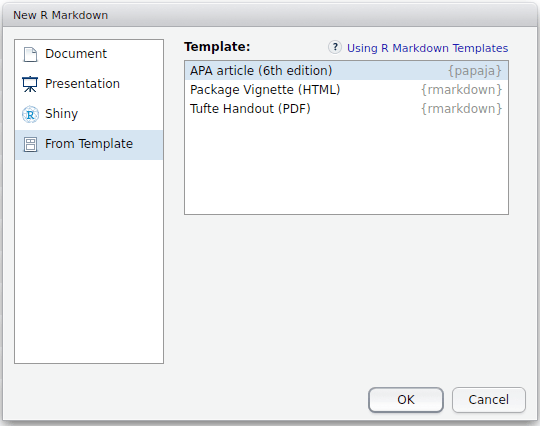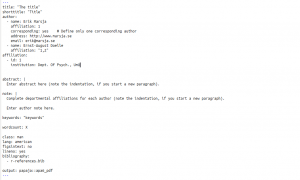Do you also find it time-consuming to make your manuscripts follow American Psychological Associations (APA) guidelines? Have you searched the internet for a good .docx/.doc APA template? After reading this post, you might not have to search anymore. Papaja is an r-package that makes your manuscript conform to APA guidelines! In this post, I will briefly describe the Papaja, how to use it to create APA manuscripts, and what I think of it.
Table of Contents
Papaja
Papaja provides an RMarkdown template used with R to create manuscripts (PDFs or Word Documents). However, listed as an experimental feature, output your manuscript as Word Document, does not work properly. I have successfully created some PDFs that seem to conform to the APA 6th Edition guidelines. Papaja creates documents using the LaTeX document class apa6 and a .docx-reference file.
It is also cross-platform, which I like. That is, you should be able to run Papaja on Linux, OS-X, and Windows systems. However, I ran into some problems with running it on a computer running Windows 8.1. Despite the fact that I followed that I did follow the installation instructions (available on the GitHub page). If you are already using Rstudio using Papaja is quite easy:

After choosing the APA article template you an RMarkdown template will be created (.Rmd). In the templates header, you insert the manuscript title, the author name(s) and affiliation(s). It is very easy to understand where and what you should put your information.
References using Papaja
If you are using a reference manager (e.g., Zotero or Mendeley) you can use it to export the citations you used, or will use, in your manuscript to a .bib-file. The .bib-file should be placed in the manuscript folder (i.e., where the .Rmd is saved) to make it possible to load it within Papaja (see the line under the heading “Bibliography” in the YAML-header).
Adding Citations in RMarkdown

To add citations to your manuscript you use the reference citation key. For instance, if you want to have in-text citation you write @NameYear (e.g., @Marsja2015). Note, in-text citations for references with many authors will appear in the text with the ampersand symbol (“&”) and not the word “and” (see this issue for more information). For citations in parentheses, you write [@NameYear].
Adding citations this way, and including your .bib-file in the YAML-header, will create a reference list after the text body of your manuscript. It will be hard to cite something and not include it in the reference list. Since Papaja uses Citation Style Language (csl) you can get your reference to conform to almost every style out there. As long that there is a .csl file. You can find styles at citationstyles.org, but you can also create one yourself.
R and Papaja: How to use Papaja Example
Papaja also provides some r-functions that created to make, for instance, the reporting some common statistical tests easier. There are functions for creating bar plots, creating tables, reporting ANOVAs, etc. I have only used the apa_table function so far. RMarkdown also makes it possible to run the R-code at the same time as the manuscript is created. This further makes it possible to extract the results and output them in the text.
R example
```{r descriptives, print=FALSE, echo=FALSE, message=FALSE}
require(dplyr)
group.by.trialtype <- group_by(exp1.data, subjectid, trialtype)
exp1 <- summarise(group.by.trialtype, M_Accuracy=mean(Accuracy), SD_Accuracy=sd(Accuracy)```Code language: R (r)Example: Performance in the visual task was overall good (*M* = `r exp1$M_Accuracy`, *SD*, = `r exp1$SD_Accuracy`).
In the above example, the data from experiment 1 is summarized using the package dplyr. The “` indicates that it is a R-code segment and so does the ` in the example after the above code snippet is also so that R will be run to output the accuracy (‘*’ surrounding the ‘M’ will output it italicized). As one can read on Papajas GitHub page that is under development. Therefore, this post might get updated when the package is improved.
A brief note, the package we used in example above, is one of the packages in the Tidyverse package. I highly recommend you use this package as you can, for example, easily use dplyr to remove columns in R.
Reproducibility, R, RMarkdown, and Papaja
If we want to create a fully reproducible manuscript, including the creation of tables, figures, and data analysis we can use Binder together with R. In a recent post, we can learn how to set up RStudio, in a browser, using Binder, mybinder, RStudio, and Git (e.g., GitHub):
Summary
Papaja is really a promising r-package for researchers publishing in journals that follow APA guidelines. However, what you really want to know might be: does Papaja it easier to create APA manuscripts? Yes and no. One the one hand, If you have some experience of R, RMarkdown, and Rstudio you will quickly learn how to use it; the answer is clearly yes. On the other hand, if you don’t have that experience and knowledge it might take more time learn Papaja. However, I would still suggest that you do. Leave writing in Word, doing statistics using SPSS, and start using R, Rmarkdown, and Papaja. Despite this, I suggest that you leave the secure environment of graphical user interfaces (eg, Microsoft Word and SPSS) and learn R Rmarkdown and Papaja. Once you have done this you will create beautiful APA manuscripts in no time!
